TL;DR
➡ Minoxidil is an FDA-approved medication for stopping hair loss that comes in either as an oral pill, liquid, or foam.
➡ Under its brand name, Rogaine, it works by increasing blood flow to your scalp and replacing thinner hair. It does not regrow new hair follicles.
➡ Despite its high effectiveness, it is not the best solution for every patient, especially not alone.
➡ All of its minor side effects can easily be resolved. With these minor setbacks alone, it is an excellent supplement medication to be used alongside other options such as Finasteride or hair transplants.
By the age of 30, 25% of men have visible hair loss, often due to male pattern baldness, and this percentage increases in proportion with age.
As balding and receding hairlines become a problem, the average hair loss patient’s first instinct is to go for the treatments they can instantly get started with.
One of these treatments is Minoxidil, a topical over-the-counter medication that has been on the market for decades.
It is a medication I’ve been prescribing my patients, both as a means to stop/slow down hair loss and as a supporting medication for hair restoration surgeries.
In this blog, I’ll go over the basics of Minoxidil, who should use it, its effectiveness, and the side effects that come with it:
Table of Contents
Let’s start by understanding what exactly it is:
What is Minoxidil Rogaine?
Rogaine, also known as Minoxidil, is a popular FDA-approved medication used in treating male pattern baldness. It either comes in the form of an oral medication you can get with a prescription; or a topical foam or liquid solution that is sold over-the-counter, which means you can get it from your pharmacy or order online right now.
Minoxidil vs Rogaine – what’s the difference?
Minoxidil and Rogaine mostly refer to the same drug, but there is a small distinction you need to be aware of.
Rogaine is the brand name of the medication that contains Minoxidil.
And Minoxidil is the active ingredient inside Rogaine that is responsible for hair growth. Minoxidil is not exclusive to Rogaine, however, as there are other medication brands, such as Loniten or Keeps, that contain the compound.
Rogaine mostly contains around 5% or 2% Minoxidil, depending on the product you’re getting.
Quick History of Minoxidil and Rogaine
Minoxidil was first developed as a medication for ulcers in the 1960s by the pharmaceutical firm Upjohn, but it didn’t prove successful in the trials.
Out of these trials, however, came an unexpected result. Minoxidil is a potent vasodilator, which refers to a substance or medication that dilates blood vessels and makes it easy for blood to flow through veins.
The U.S. Food and Drug Administration (FDA) approved the use of Minoxidil in 1979 as oral tablets with the brand name “Loniten” to treat high blood pressure.
Later, an associate professor at the University of Colorado School of Medicine, Dr. Charles Chidsey, conducted a number of studies using Minoxidil, which revealed hair growth as a side effect. He informed Dr. Guinter Kahn, who practiced dermatology at the time, of the results.
Along with his colleague Dr. Paul Grant, Kahn developed a solution that contained 1% Minoxidil to observe the effects of the substance on hair growth, which proved very successful after the initial experiments.
After the publishing of these results, dermatologists started prescribing Loniten to hair loss patients off-label.
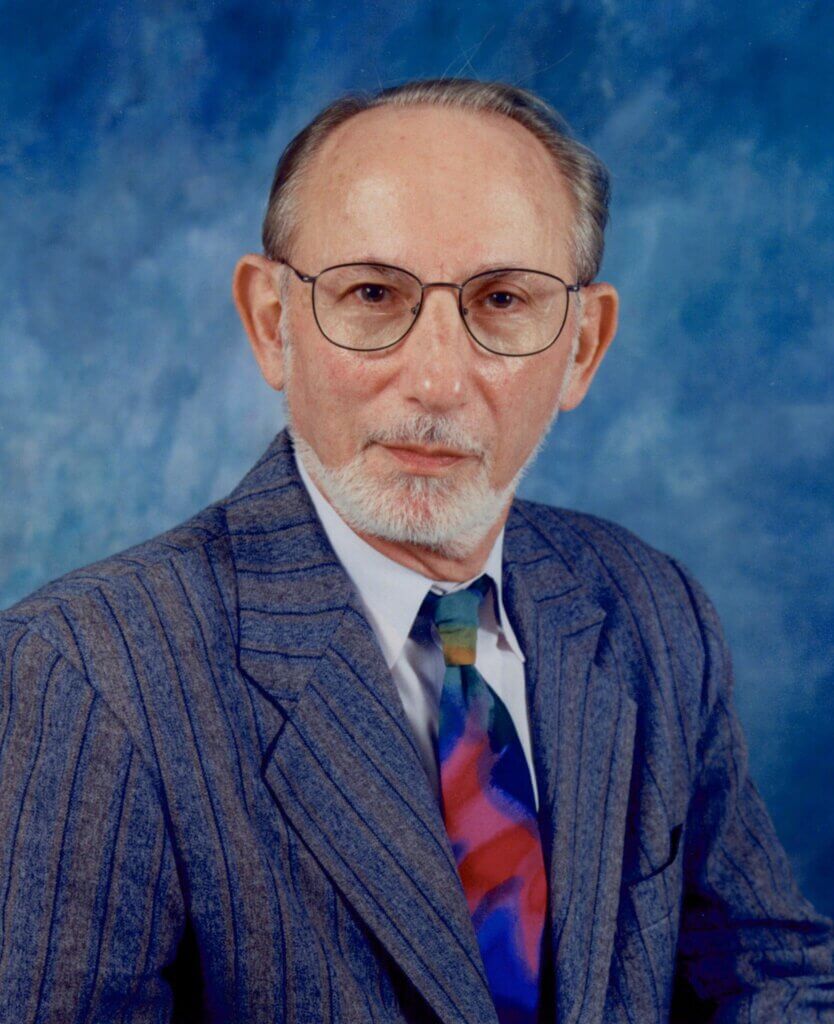
And in 1988, the FDA approved Upjohn’s Rogaine as a medication to treat hair loss and pattern baldness.
Fun Fact
Upjohn’s first choice for the name of Rogaine was “Regain”, but it was rejected by the FDA for being misleading.
- Over-the-counter selling of Rogaine without the need for prescriptions was approved in 1996.
- The 5% solution of Rogaine most patients use today was released in 1997 and was approved for over-the-counter selling in 1998.
- The foam version of the 5% Rogaine that is more widely available today was developed and approved for use in 2006.
- Many other brands also developed Minoxidil solutions, which are currently direct competitors of Upjohn and Rogaine.
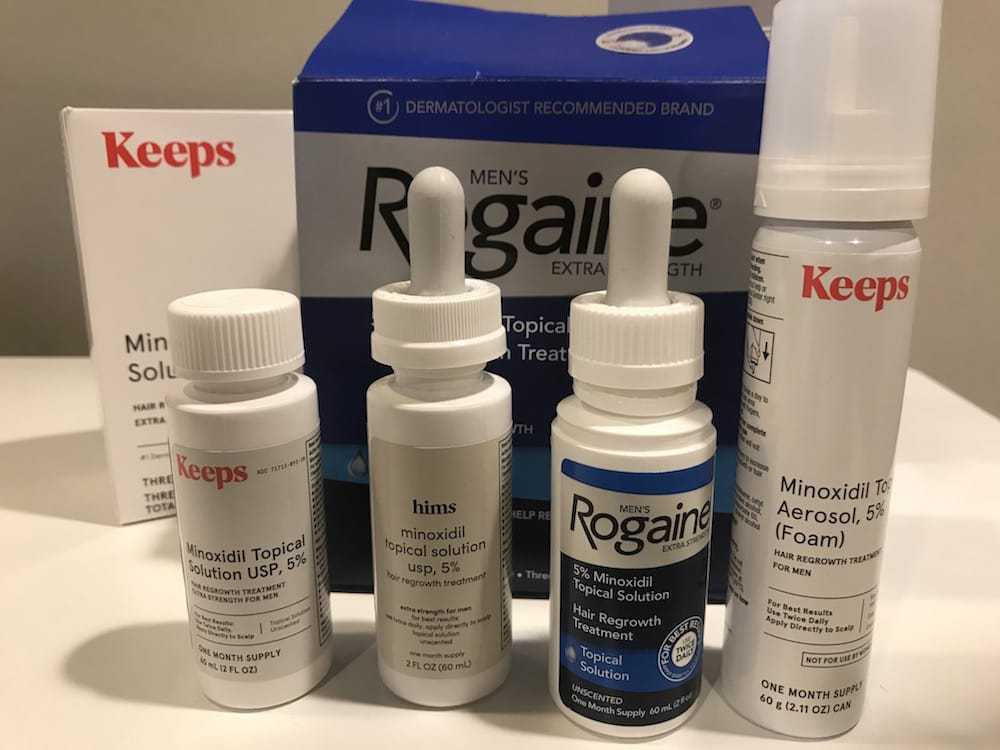
Does Rogaine Minoxidil Regrow Hair?
Rogaine Minoxidil can help with hair loss but is not the certain solution to every type of hair loss; it is actually far from that.
While there is proof it helps with hair growth and prevents further hair loss in some patients, there are also various studies that suggest it doesn’t work for everyone.
I know you’ve come here for a straight answer, but there is none.
So let me quickly explain how exactly Minoxidil works, what different studies suggest, and who the drug is suitable for:
How does Minoxidil work?
There also isn’t a straight answer to how Minoxidil causes hair growth, but there are two main theories based on the main functions of the medications.
First of which is based on Minoxidil’s vasodilatory qualities:
1- Vasodilation (increasing blood flow to the scalp)
Minoxidil was initially used to treat high blood pressure when it was shown to improve blood flow by dilating blood vessels.
Its vasodilatory qualities are presumed to be the primary way it helps with hair growth.
When Rogaine Minoxidil is applied to the scalp, the blood vessels around the balding areas are widened, causing more blood containing oxygen and nutrients to flow into your scalp.
This feeds your follicles, promoting the quicker growth of new and healthier hair, which slows, stops, or even reduces the excessive balding you’re going through.
By causing more oxygen and nutrients to flow into your scalp, it also strengthens your existing hair and ensures that it is resilient against MPB. Otherwise, it helps by replacing the existing thinner hair:
2- Replacing Thinner Hair
Hair shedding is not the only way you can experience visible balding on your scalp.
In fact, because of male pattern baldness, most of your hair follicles shrink to a certain degree before falling out, causing your hair to look thinner even before you lose hair.
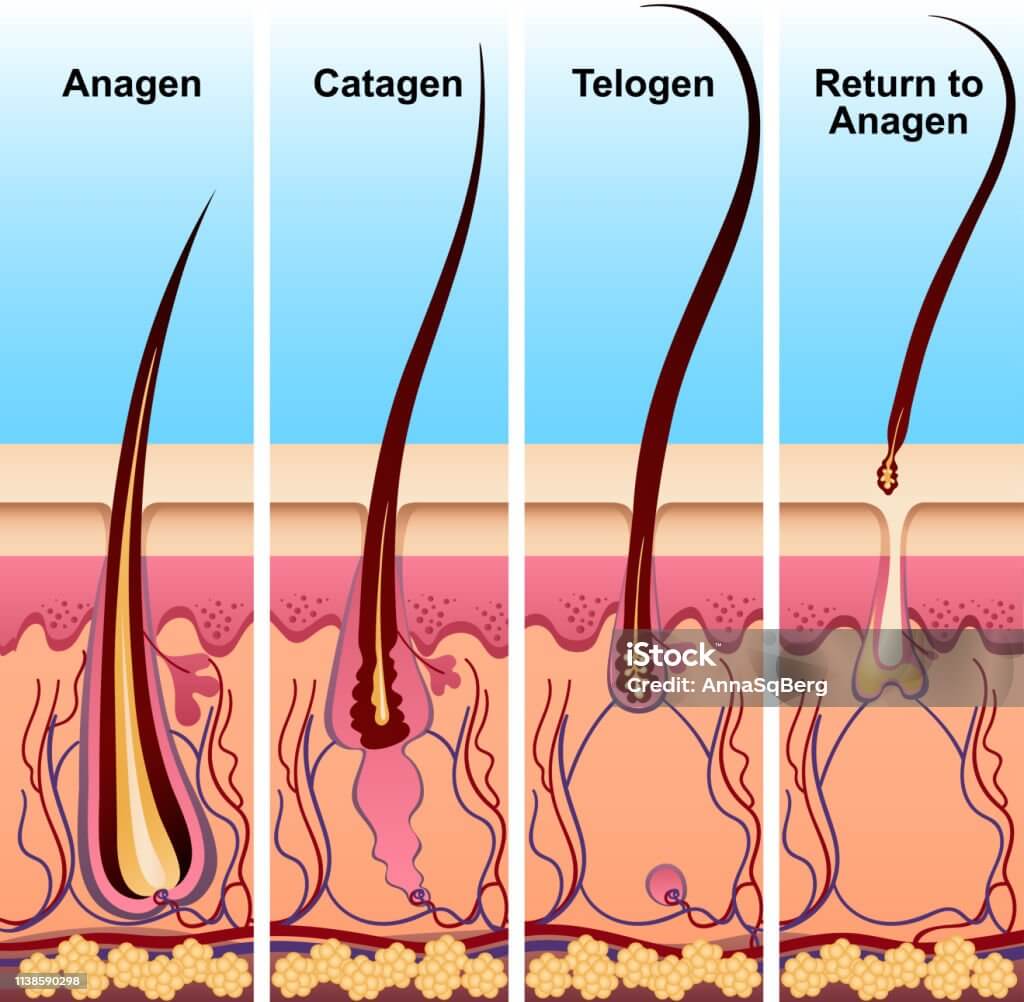
Minoxidil contains a certain type of nitric oxide moiety, which is a part of a molecule that can bind to nitric oxide and cause your hair follicles in the telogen phase to shed more quickly and stimulate your follicles to start replacing shed hair with thicker hair.
Minoxidil can’t grow new hair follicles ❌
Minoxidil doesn’t help you grow brand-new hair on your scalp.
Actually, there is currently no way to grow new hair follicles, as all the hair follicles you have at the moment were produced in the womb before you were born.
Until we find a way to reproduce hair follicles in a lab, possibly through the use of stem cells, you’ll have the same hair follicles that will inevitably fall out as you age.
What Minoxidil does is prevent the shedding of your existing hair follicles by supporting them with an increased blood flow and/or by replacing thinner hair grafts with new ones.
That’s why patients with large and complete hair loss on their scalps couldn’t see hair growth on these bald areas after using Minoxidil.
What recent studies and patient reviews say about Minoxidil
So, yes, Minoxidil can prevent hair loss and promote hair growth, but to what extent?
Let’s look at the studies conducted over the years and real-life patient testimonies to see the numbers and exact effectiveness of Rogaine Minoxidil:
A 12-Month Study on 904 Patients in Germany (1)
▶ In 2003, dermatologists conducted an observational study on 904 patients with male pattern baldness to understand the efficacy of 5% Minoxidil topical solutions.
▶ Patients applied 1 ml of the Minoxidil solution twice a day on their scalp to the areas with hair loss.
▶ After 12 months, areas with hair loss were observed to become smaller in 62% of the patients.
▶ The balding areas stayed the same for 35.1% of the patients, and further hair loss was observed in 2.9% of the patients.
▶ 84.3% of the patients rated the Minoxidil solution as “very effective”, “effective”, or “moderately effective”, while 15.7% of the patients rated it “ineffective.”
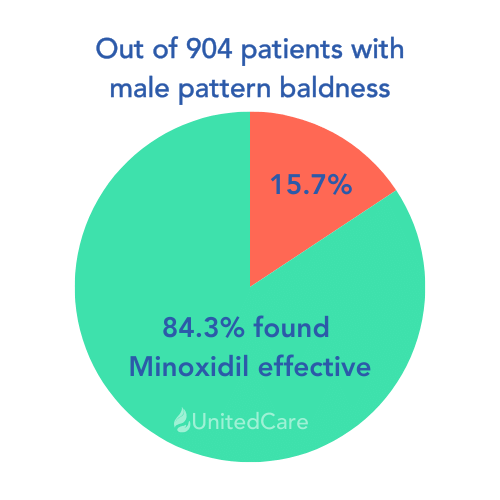
A Study Comparing the 5% vs 2% Minoxidil Solutions With 393 Male Patients (2)
▶ In 2002, a placebo-controlled multicenter clinical trial was conducted by a number of dermatologists to evaluate the effects of 2% and 5% Minoxidil solutions on male pattern baldness.
▶ 393 male patients with androgenetic alopecia, aged 18-49, were randomly assigned a 2% Minoxidil solution, a 5% Minoxidil solution, or a placebo solution twice a day for 48 weeks.
▶ After 48 weeks, the 5% Minoxidil solution proved significantly better results in terms of the change in the number of non-vellus hair, patient ratings, and investigator rating of scalp coverage.
▶ 5% Minoxidil solution provided 45% more hair growth on average after 48 weeks, and hair growth started significantly earlier than the 2% Minoxidil solution.
▶ No systemic or side effects, such as scalp irritation, were observed during the study.
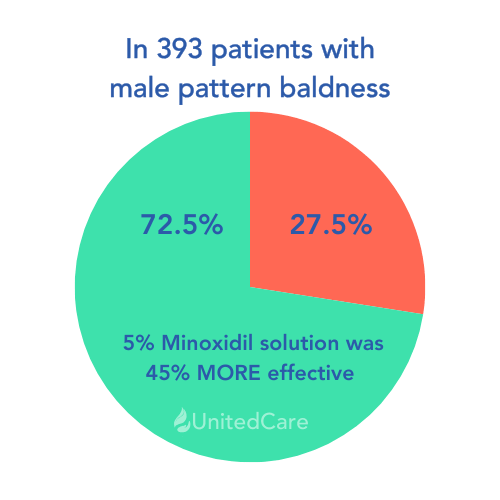
A 6-Month Study on 17 Male Patients (3)
▶ In 2016, an observational study on the efficacy and the safety of 5% Minoxidil foam was conducted on 17 patients throughout 16 and 24 weeks.
▶ Patients were asked to apply 1 ml of 5% Minoxidil foam on their scalps daily for 6 months.
▶ Through assessments of hair counts, patient ratings, and photographic reviews, there was a significant improvement in hair loss for most patients after 24 weeks.
A Reddit User’s Personal Experience and Review of Minoxidil (4)
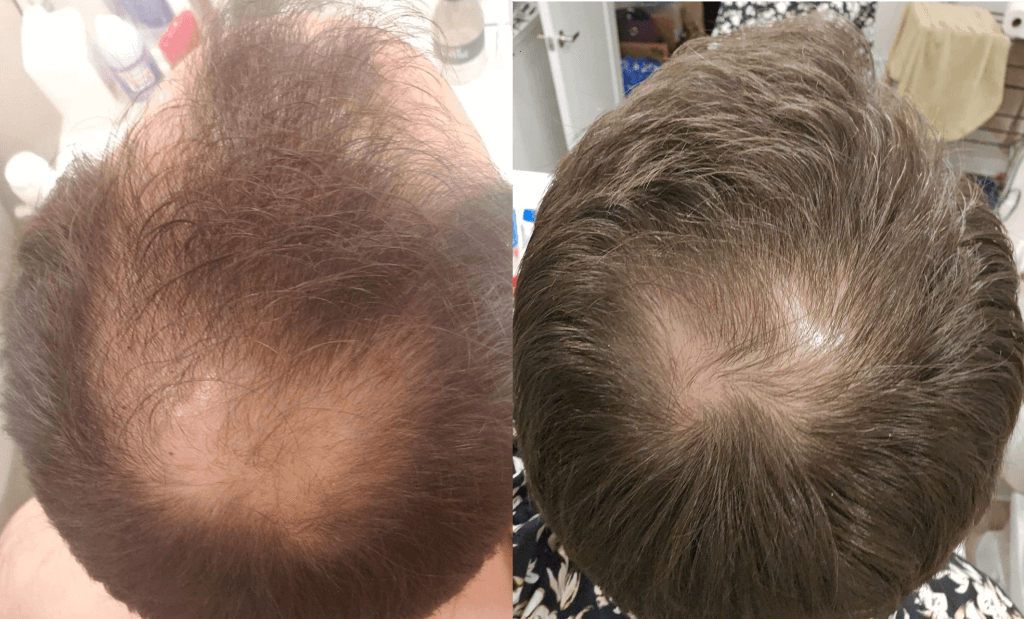
This Reddit user has been using topical Minoxidil for over a year and combining it with Finasteride to increase its effectiveness.
The overall results look highly successful as it is also supported by the user’s own words:
“Hair is obviously a bit longer at this point, but the difference is pretty pronounced. For just topical fin+min, I’m pretty impressed.”
Additionally, to give my own medical evaluation:
In my own professional life, I confidently suggest Minoxidil to many people as its effectiveness rate is seen in 40% of the patients.
Usually, its initial effects are seen at the end of the 6th month. By then, hair loss completely stops, and the overall hair growth rate increases by 20 to 40%.
And clinically, 40% rate is an immensely high-rate, which is why every patient who is experiencing hair loss should try Minoxidil and decide its worth based on their own observations.
What most studies don’t say
Minoxidil is highly likely to promote hair growth for male patients with pattern baldness.
As the results of most studies suggest improvements in hair density and count alongside better coverage on bald areas, the hairline is not restored, or frontal hair loss is not reversed.
⚠️ However, it is NOT a one-time solution. The effects wear off once you stop using it.
So, patients are expected to keep using Minoxidil to avoid further hair loss for years, as men who stopped using Minoxidil observed rapid hair loss after the discontinuation of the drug. In fact, for the majority of these patients, hair counts were below the numbers that were recorded when they started using Minoxidil in the first place.
Minoxidil is not the perfect method to regrow your lost hair.
And when it comes to stopping hair loss, it’s not the best method for everyone:
Who should use Rogaine Minoxidil?
Experiencing hair loss, unfortunately, doesn’t make you the perfect candidate for using Rogaine. There are a few other variables to evaluate before deciding.
Studies suggested that Minoxidil was more effective in patients with:
- Male Pattern Baldness/Androgenetic Alopecia
- Smaller areas with hair loss
- Progressing hair loss for under 5 years
- Central hair loss rather than frontal hair loss
- Patients who are not eligible for using other medications such as Finasteride (or simply don’t want to)
So if you have been experiencing hair loss for a long time and have relatively large bald areas located more on the front of your scalp, you’re not going to get the desired improvements from using Rogaine Minoxidil.
How should Minoxidil be used?
The topical solutions and foams of Minoxidil are mostly preferred for treating hair loss.
The general directions of these medications suggest using 1 ml of the liquid solution or half a cap of the foam to the scalp twice a day, focusing on the areas with hair loss.
Additionally, it can be used before/after a hair transplant, and there are various studies suggesting improved results after using oral Finasteride and topical Minoxidil together.
For most optimal results, I suggest hair transplant patients to start using topical Minoxidil in combination with oral Finasteride 1 month after the surgery.
Alternatively, for patients who want to or need to use Minoxidil alone, I can say that despite not being perfect, it will still be an effective solution:
How does Rogaine Minoxidil shine compared to alternatives?
For patients who do not wish to undergo heavy medical therapies such as PRP treatments or laser therapies, Minoxidil can be beneficial:
1️⃣ As a topical over-the-counter medication, it is cheaper.
2️⃣ Since it is a daily medication that you can use or stop whenever you want, its effects are easier to control.
Also, if lighter medical options that also come in the form of foams or pills, such as Finasteride, are not an option for you, Minoxidil can help because:
3️⃣ The topical version is non-invasive as it does not invade your bloodstream, only affecting your scalp’s skin.
4️⃣ Its working mechanism increases the growth phase of each hair follicle. So, its benefits fade away slower than other medications.
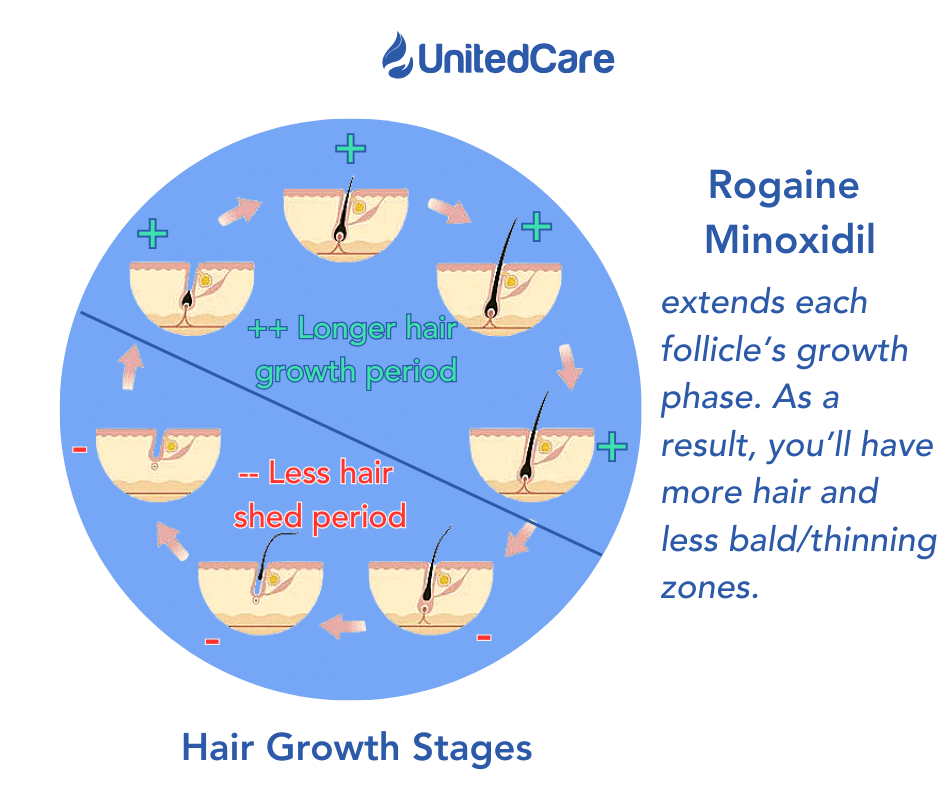
5️⃣ By not affecting your entire bloodstream, its potential risks are limited only to skin-related issues.
Overall, with all the benefits combined, we can say that Minoxidil’s most appealing difference is the fact that it is a safer option compared to its alternatives.
However, it doesn’t mean it is entirely free of side effects:
Side Effects of Minoxidil Rogaine
Rogaine has a number of side effects that can be experienced around the scalp or systemically.
Systemic effects include an increased high rate due to the vasodilatory qualities of the substance, but the chances of experiencing this side effect are extremely low as the topical Minoxidil is mainly applied around the scalp.
Other side effects include:
- Sensitive scalp and itchiness
- Irritation, redness, or burning around the applied areas
- Dry skin on the applied areas
- Flaky skin around the scalp
In some rare instances, patients may see some white particles on their scalps that resemble dandruffs.
These happen due to follicular occlusion and increase in scalp oil (sebum) caused by the auxiliary substances used.
If you experience this, I recommend taking a one-week break and trying a different brand after informing your doctor about the situation.
💡One common myth about the medication is that you might’ve heard or read about Rogaine causing erectile dysfunction or adversely affecting sexual performance.
While these side effects are common with other hair loss medications, such as Finasteride, there are NO studies that connect Minoxidil with these conditions.
Alternatively, due to the way Minoxidil works, there are some instances that can be seen as a side effect but are not.
One of them is the initial shedding that might be perceived as permanent damage by some patients:
Does Minoxidil cause permanent hair loss?
No, absolutely not.
👉 Minoxidil causes some amount of hair loss due to temporary shedding only in the initial phase; however, this is NOT permanent. And it can be proven with the ingredients of Minoxidil.
Drugs with Minoxidil active ingredients cause all the hair in the telogen phase to fall out because Minoxidil’s active ingredients increase the blood flow in the scalp, which quickens the body’s hair recycling process.
That is why, after the first 4-8 weeks, your scalp enters the anagen phase and starts regrowing hair.
This is the reason for your hair loss, a temporary side effect due to the way Minoxidil works.
It is definitely NOT permanent hair loss. Therefore, when a person starts to use Rogaine, he/she should continue using it for at least 4 months.
No need to stress and panic; just keep using it. And you will achieve great results. 🍀
Is Minoxidil not working for you?
Minoxidil is not a final solution to hair loss.
Yes, it can help boost hair growth.
And yes, it can slow/stop hair loss.
But using Rogaine, you can’t get your natural look back with a restored hairline and a full head of hair.
At least not alone:
Hair Transplant Surgeries at UnitedCare – a more effective and certain solution to hair loss
At UnitedCare, we’ve adopted a holistic approach to a much better and more effective solution to hair loss and hair transplants.
From the first examination to long after your operation, we’re with you, providing you and your body with everything necessary to get your looks back.
Address the Causes of Hair Loss 🩺
Starting with the first examination, we understand and diagnose the causes of your hair loss.
Then, we evaluate your options and decide on the best course of action for you together.
Restore Your Hairline with a Dermatologist 🥼
Hair loss is a medical condition that affects both your appearance and mental health; only a dermatologist doctor can effectively treat it according to the characteristics of your body, skin, and hair.
At UnitedCare, our dermatologist doctors approach your condition with the intention of helping you live the rest of your life without worrying about hair loss.
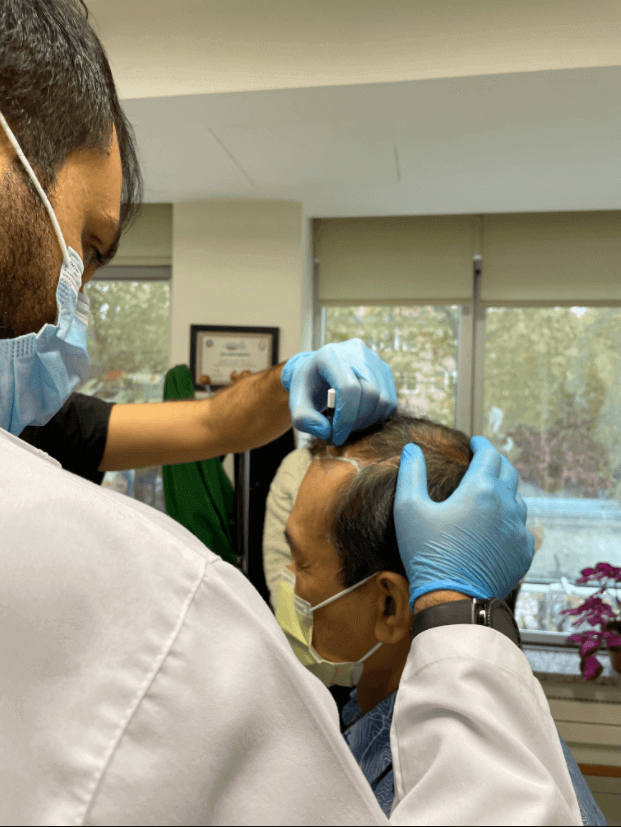
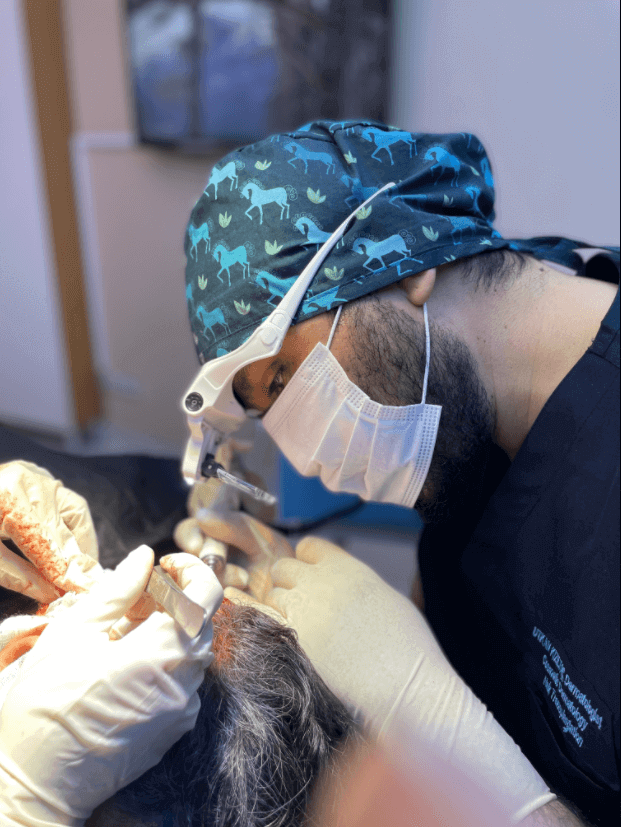
Hair Transplant Surgeries with Advanced Techniques and Technologies 💉
Hair transplants have come a long way since the 1950s when they were first invented, yet most clinics still use outdated methods and equipment.
We use Sapphire FUE, DHI transplants, bio-enhancements, and various other techniques and technologies applied by the top clinics worldwide during the surgery.
Best Results Come with the Best After-Care 👱♂️
To get the best results, you need to apply the right medications, practices, and habits before and after the surgery.
We adopt and suggest scientifically proven ways and products to boost your recovery and improve the chances of your hair transplant’s success with regular check-ins after the surgery.
You’re one click away from getting your hair back: 👇
Restore your natural look with the proper consultation:
UnitedCare’s expert dermatologists are here to support your hair regrowth with Minoxidil and more.
Frequently Asked Questions (FAQs)
Is Minoxidil good for hair growth?
Yes, studies prove using Minoxidil for a long period of time proved consistent hair growth in thinning areas of the scalp.
Is Minoxidil hair permanent?
No, hair growth achieved by using Minoxidil is not permanent. On the contrary, studies observed rapid hair loss after discontinuation of Minoxidil usage.
Is Rogaine good for thinning hair?
Yes, Rogaine can promote hair growth on thinning areas of your scalp by promoting blood flow to your scalp.
Which is better, Rogaine or Minoxidil?
Rogaine and Minoxidil can’t be compared since Rogaine is the brand name of the hair loss medication that contains a certain amount of Minoxidil in it, which is a chemical compound that causes hair growth on thinning areas of the scalp.
Yes, Rogaine can promote hair growth on thinning areas of your scalp by promoting blood flow to your scalp.
Does Minoxidil cause permanent hair loss?
No, absolutely not. It is true that Minoxidil will cause some amount of hair loss due to temporary shedding. However, this is not permanent.
Drugs with Minoxidil active ingredients cause all the hair in the telogen phase to fall out because Minoxidil’s active ingredients increase the blood flow in the scalp, which quickens the body’s hair recycling process. That is why, after the first 4-8 weeks, your scalp enters the anagen phase and starts regrowing hair. It is definitely not permanent hair loss. Therefore, when patients start to use Rogaine, they should continue using it for at least 4 months.
What is the success rate of Rogaine Minoxidil?
According to a 12-month-long study made on 904 patients, in 62% of the patients, balding areas became smaller after they applied 1 ml of the Minoxidil solution on their balding twice a day. As a result, 84.3% of the patients rated the Minoxidil’s success rate as “very effective”, “effective”, or “moderately effective”.
What are the side effects of Minoxidil?
Sensitive scalp that causes itchiness, irritation, redness, or burning on the applied areas are amongst the potential side effects of Minoxidil. However, as the medication is seen as one of the safest hair loss treatments out there, these side effects are extremely rare. And if they appear, you can reverse them if you simply stop using it.
Does Minoxidil help receding hairline?
As Minoxidil works by increasing blood flow to your scalp, it can help receding hairline by replacing thinner hair and recreating a healthier one over time. However, keep in mind that for much more progressed situations, some examples of receded hairline may not be brought back as Minoxidil does not regrow new hair follicles.

References
- Jan Rundegren, A one-year observational study with minoxidil 5% solution in Germany: results of independent efficacy evaluation by physicians and patients 1 1The author is employed by Pharmacia AB (part of the Pfizer Group), Journal of the American Academy of Dermatology, Volume 50, Issue 3, 2004, Page 91, https://doi.org/10.1016/j.jaad.2003.10.289
- Bruce Kohut (2005). A Study to Evaluate the Effectiveness and Safety of 5 Percent Minoxidil Foam in the Treatment of Male Pattern Hair Loss. https://clinicaltrials.gov/ct2/show/study/NCT00151515
- Olsen, E. A., Dunlap, F. E., Funicella, T., Koperski, J. A., Swinehart, J. M., Tschen, E. H., & Trancik, R. J. (2002). A randomized clinical trial of 5% topical minoxidil versus 2% topical minoxidil and placebo in the treatment of androgenetic alopecia in men. Journal of the American Academy of Dermatology, 47(3), 377–385. https://doi.org/10.1067/mjd.2002.124088
- Hasanzadeh, Hournaz & Ahmad Nasrollahi, Saman & Halavati, Nader & Saberi, Maryam & Firooz, Alireza. (2016). Efficacy and safety of 5% minoxidil topical foam in male pattern hair loss treatment and patient satisfaction. Acta dermatovenerologica Alpina, Pannonica, et Adriatica. 25. 41-44. 10.15570/actaapa.2016.12.
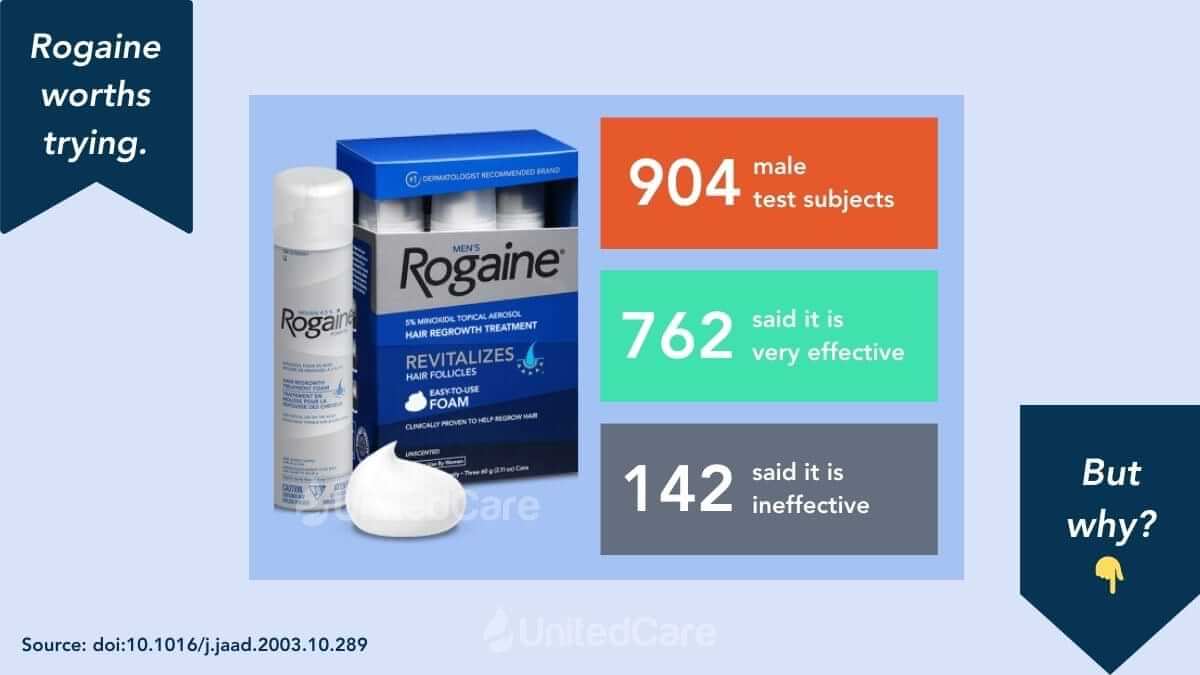
I’ve started 7 percent Rogaine and finsteride. It’s been 5 weeks. I am loosing tons of hair. I was not shedding this badly till I started rogaine. I had a scalp biopsy. It says my hair is in the Tellegen phase. Should I continue Rogaine.
Hello Kathy,
We know that drugs with minoxidil active ingredient cause all the hair in the telogen phase to fall out and grow in the anagen phase for the first 4-8 weeks.
This is the reason for your hair loss.
It is definitely not permanent hair loss. Therefore, when a person starts to use rogaine, he/she should continue using it for at least 4 months.
No need to stress and panic; just keep using it.
Good luck 🍀
Hello! i’m using minoxidil 2%.After using 2 weeks and I feel my scalp itchy and noticed white dead cell come out look like dandruff. Is this common side effect or still can i use this medicine?
Hello Thae,
It is a side effect that can occur in some individuals.
This often happens not due to an allergy, but because of follicular occlusion and an increase in scalp oil (sebum) caused by the auxiliary substances used.
I recommend taking a one-week break and trying a different brand.
Best.